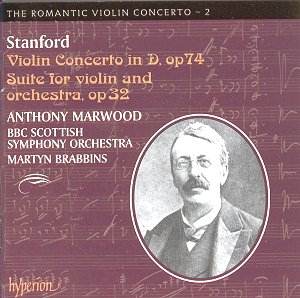Charles Villiers STANFORD
Suite in D, op.32 for violin and orchestra;
Violin Concerto no.1 in D, op.74
 Anthony Marwood (violin)
Anthony Marwood (violin)
BBC Scottish Symphony Orchestra/Martyn Brabbins
 Hyperion CDA67208
[66:40]
Hyperion CDA67208
[66:40]
Crotchet
AmazonUK
AmazonUS

Stanford's writing for violin and orchestra was fairly extensive. An early
concerto (1875 - the same year as the first symphony) was suppressed but
not destroyed and was followed by the Suite on this record which Joachim
played at the famous Stanford concert with the Berlin Philharmonic Orchestra
in 1889 (how many British composers since have been invited to conduct an
entire programme of their music with that orchestra?).
The first concerto likewise enjoyed distinguished advocacy from its dedicatee
Arbós and from Fritz Kreisler, no less, yet it may not have been played
between 1918 and this recording of 2000. Maybe it was the chance to rehear
this first concerto which inspired Stanford to write a Second in 1918, followed
by a set of Variations in 1921 and the Sixth Irish Rhapsody in 1922 (recorded
by Lydia Mordkovich on Chandos). The Second Concerto and Variations may have
survived only in MS transcriptions for violin and piano. Still, the full
score of the First Concerto is a recent discovery so let us hope this disc
will one day have a companion.
Stanford can be a puzzler, to those who know a wide range of his music even
more than to those who don't. The Suite is a far from lightweight piece composed
in a romantic idiom with sensitivity and obvious feeling, and with no apparent
resemblance to any other Stanford work I know. The sheer variety of his output
is such that we will never entirely know him until all his music is available
to us (and that would be a very large-scale undertaking indeed).
I think that, had I heard the Concerto "blind", I would have recognised the
composer from the cut of the themes, yet it expands our knowledge of him
wonderfully. The way in which the innocent opening is expanded to support
effortlessly the vast structure of the first movement is unprecedented in
my knowledge of his work. Nor does he flag in the slow movement, which expands
passionately in its central section and closes with deep poetry (and what
formal originality, again, to have the cadenza in the slow movement rather
than the first, as usual), or in the finale with its entrancing folkloristic
colouring.
A little bird (present at the sessions) had warned me that the performers
had taken the first movement too slowly. I disagree. I think they have understood
perfectly the still soul at the centre of the work, which the grander moments
rise out of but never dispel (even in the lively finale it is the poetry
which remains in the mind). Since I have sometimes been critical of Stanford
performances which others have lauded to the skies (the Varcoe song-recordings,
for instance) I hope my total praise for the performances on this disc will
ring all the truer.
I have always felt that Stanford was a great composer only in his smaller
vocal works, and perhaps the Irish Rhapsodies. Despite fine and magnificent
moments, even whole movements, in the not inconsiderable series of instrumental
works which we now have on CD, I can't quite place the piano concertos among
the great piano concertos or the symphonies among the great symphonies. I
hope I won't be repenting in ten years' time for my rashness but this violin
concerto really does seem to belong among the great violin concertos. How
interesting that he achieved this in a work which completely abandons Brahmsian
structural logic in favour of an anticipation of Sibelian "growth-and-collapse"
which allows him to unlock his true romantic nature.
Snap up this beautifully engineered disc without delay - I can't recommend
it too highly.
Christopher Howell


